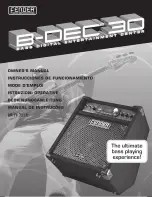
stewmac.com
9
The top and back are slightly oversize, with edges that hang
over the sides . This overhang will be removed after gluing .
Glue the back and top
To get good clamping pressure all around the back, the
body mold is now put to use again . By adding screw eyes
or hooks around the edges of the of the plywood, you can
use the rubber clamping band included with your kit . If
your clamping band is an unbroken loop, cut it to make it
one long strip .
Tie the end of the clamping band and stretch it tightly over
the body to the opposite corner . Continue strapping from
corner to corner until the back is clamped under a web
of rubber bands . Tie off the end to one of the screw eyes .
Try this as a dry run .
When you’re ready for glue, apply it to the edge of the side
and lining, and to the end of the neck and tail blocks . Put the
back in position and wrap with the rubber clamping band .
Let the glue dry for 45 minutes, then remove the body from
the mold . Clean away any dripped glue, especially where it
can be seen through the soundhole of the assembled body .
Place the body back into the mold and repeat the process
to glue the top on .
Trim the overhang
The top and back needs to be trimmed to make them flush
with the sides . This involves cutting the overhang to make
it very slight, then sanding away the remainder to make
the edges smooth and even .
A Dremel rotary tool with StewMac’s Precision Router Base
and Edge Guide is ideal for trimming the overhang . Use a
downcut router bit to make a clean cut . Rout away most
of the overhang, leaving it small enough to remove with
sandpaper .
You can also trim the overhang with a sharp razor knife and
a flat file . Using the knife, carve away a small bit of wood
with each cut, reducing the overhang until it is close to the
sides . Follow with the file to bring it close enough to remove
with sandpaper .
Beware of tearout. Whether you use a router or a knife, you
must pay attention to the grain of the wood on the body
curves—especially with the top which is solid mahogany,
not laminated .
At the curves, a cutting tool working against the grain wants
to dig into the wood . This action makes it easy to tear out a
chunk of wood . See the illustration on the next page .
To avoid tearout, plan your cuts so that the router or knife
appoaches each curve on its downward slope, rather than
climbing upward . The eight arrows on the illustration show
the direction to make each cut around the body .
Summary of Contents for ukulele kit
Page 1: ...Sheet i 5351 Updated 11 17 Assembly Instructions UKULELE KIT StewMac ...
Page 21: ...stewmac com 21 ...
Page 22: ...stewmac com 22 ...
Page 23: ...stewmac com 23 ...










































